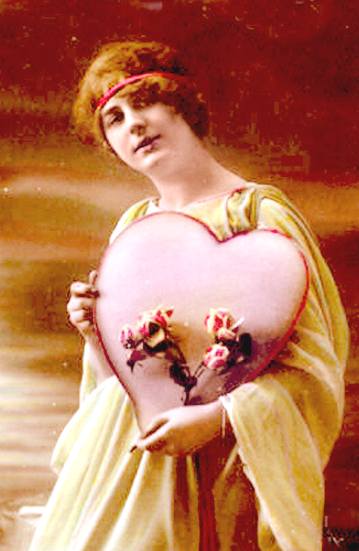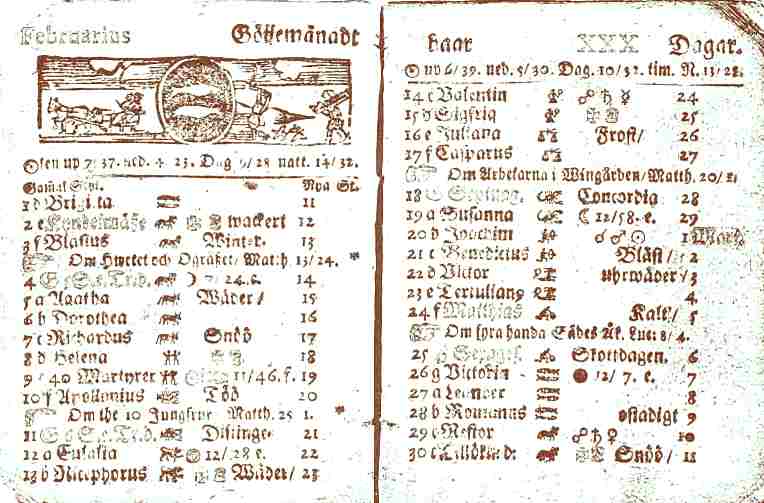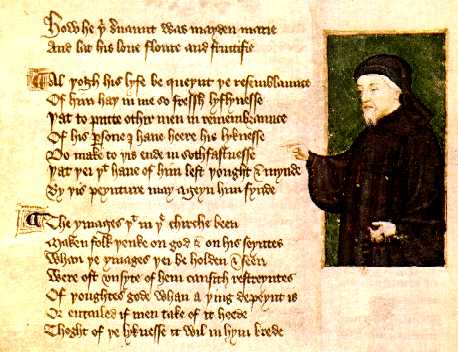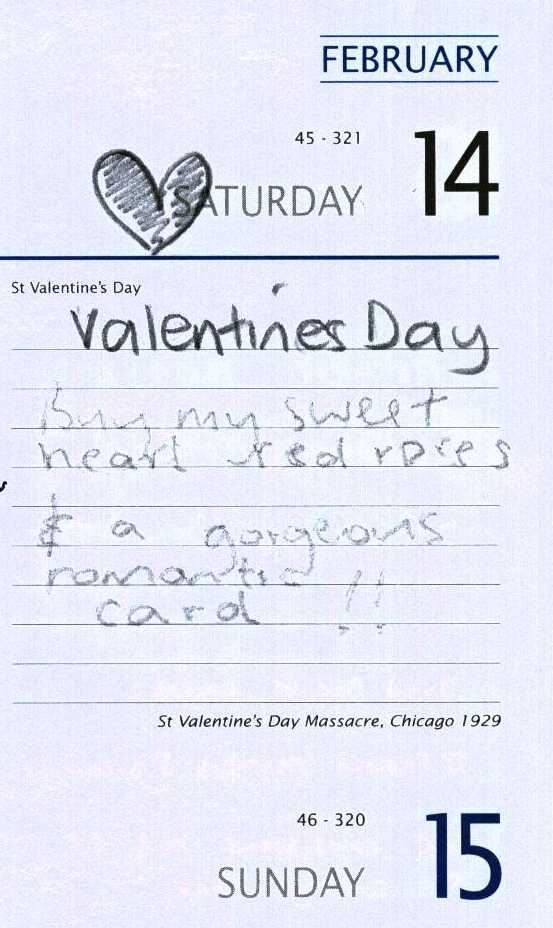|
VALENTINES DAY & BUNNY BOILERS
|
|
|
|
Saint Valentine's Day or Valentine's Day is on February 14. It is the traditional day on which lovers express their love for each other; sending Valentine's cards, candy, or donations to charities, often anonymously. It is very common to present flowers on Valentine's Day. The holiday is named after two men, both Christian martyrs named Valentine. The day became associated with romantic love in the High Middle Ages, when the tradition of courtly love flourished.
The day is most closely associated with the mutual exchange of love notes in the form of "valentines". Modern Valentine symbols include the heart-shaped outline and the figure of the winged Cupid. Since the 19th century, handwritten notes have largely given way to mass-produced greeting cards. The Greeting Card Association estimates that approximately one billion valentines are sent each year worldwide, making the day the second largest card-sending holiday of the year behind Christmas. The association estimates that women purchase approximately 85 percent of all valentines.
In the United States, the marketing of Valentine's Day has tagged it as a "Hallmark holiday". A recent trend has been to refer to February 14 as "Singles Awareness Day."
Ironically, it was the sending of a Valentine card in February of 2006, that may have planted the seeds of an idea in the mind of one young girl in Sussex, England. That could well be the case, where this girl admitted to dreaming of making love to the man she later accused of sexual assault. New evidence from a person attending a party tends to support this theory. But, could this lead to an Appeal?
Valentine's Day postcard, circa 1910
History
February fertility festivals
On the ancient Athens calendar, the period between mid-January and mid-February was the month of Gamelion, dedicated to the sacred marriage of Zeus and Hera.
In Ancient Rome, February 15 was Lupercalia. Plutarch wrote:
The word Lupercalia comes from lupus, or wolf, so the holiday may be connected with the legendary wolf that suckled Romulus and Remus. Lupercalia was a festival local to the city of Rome. The more general Festival of Juno Februa, meaning "Juno the purifier" or "the chaste Juno," was celebrated on February 13-14. Pope Gelasius I (492-496) abolished Lupercalia. Some historians argue that Candlemas (then held on February 14, later moved to February 2) was promoted as its replacement, but this feast was already being celebrated in Jerusalem by AD 381. The pope also declared in 496 that the feast of St. Valentine would be on February 14.
Chaucer's love birds
The first recorded association of Valentine's Day with romantic love is in Parlement of Foules (1382) by Geoffrey Chaucer:
This poem was written to honor the first anniversary of the engagement of King Richard II of England to Anne of Bohemia. A treaty providing for a marriage was signed on May 2, 1381.[5] (When they were married eight months later, he was 13 or 14. She was 14.)
Chaucer's Parliament of Foules is generally set in a supposed context of an old tradition, in fact had no such tradition before Chaucer. The speculative explanation of sentimental customs, posing as historical fact, had their origins among eighteenth-century antiquaries, notably Alban Butler, the author of Butler's Lives of Saints, and have been perpetuated even by respectable modern scholars. Most notably, "the idea that Valentin'e Day customed perpetuated those of the Roman Lupercalia has been accepted uncritically and repeated, in various forms, up to the present"
On the liturgical calendar, May 2 is the saints' day for Valentine of Genoa. This St. Valentine was an early bishop of Genoa who died around AD 307[6][7]. Readers incorrectly assumed that Chaucer was referring to February 14 as Valentine's Day. However, mid-February is an unlikely time for birds to be mating in England.
Swedish calendar showing St Valentine's Day, February 14, 1712
Medieval and modern times
Using the language of the law courts for the rituals of courtly love, a "High Court of Love" was established in Paris on Valentine's Day in 1400. The court dealt with love contracts, betrayals, and violence against women. Judges were selected by women on the basis of a poetry reading.
The earliest surviving valentine dates from 1415. It is a poem written by Charles, Duke of Orleans to his wife. At the time, the duke was being held in the Tower of London following his capture at the Battle of Agincourt.
It is probable that the various legends about St. Valentine were invented during this period. Among these legends:
Valentine's Day is mentioned by the character Ophelia in Hamlet: "Tomorrow is Saint Valentine's Day."
In 1836, relics of St. Valentine of Rome were donated by Pope Gregory XVI to the Whitefriar Street Carmelite Church in Dublin, Ireland. In the 1960s, the church was renovated and relics restored to prominence.
In 1969, as part of a larger effort to pare down the number of saint days of purely legendary origin, the Church removed St. Valentine's Day as an official holiday from its calendar. February 14 is now dedicated only to Saint Cyril and Saint Methodius.
Valentine's Day in North America
Valentine's Day was probably imported into North America in the 19th century by British settlers. In the United States, the first mass-produced valentines of embossed paper lace were produced and sold shortly after 1847 by Esther Howland (1828-1904) of Worcester, Massachusetts. Her father operated a large book and stationery store, and she took her inspiration from an English valentine she had received. Since 2001, the Greeting Card Association has been giving an annual "Esther Howland Award for a Greeting Card Visionary."
In the second half of the 20th century, the practice of exchanging cards was extended to all manners of gifts in the United States, usually from a man to a woman. Such gifts typically include roses and chocolates. In the 1980s, the diamond industry began to promote Valentine's Day as an occasion for giving jewelry.
The day has come to be associated with a generic platonic greeting of "Happy Valentine's Day."
In some North American elementary schools, students are asked to give a Valentine card or small gift to everyone in the class. The greeting cards of these students often mention what they appreciate about each other.
Some people see Valentine's Day as an opportunity to give to charities and help others.
Portrait of English poet Geoffrey Chaucer by Thomas Hoccleve (1412). Earliest known link between Valentine's Day and romance is found in Chaucer's poetry
Valentine's Day and its equivalents in other cultures
Thanks to a concentrated marketing effort, Valentine's Day has emerged in Japan and Korea as a day on which women, and less commonly men, give candy, chocolate or flowers to people they like. This has become an obligation for many women. Those who work in offices end up giving chocolates to all their male co-workers, sometimes at significant personal expense. This chocolate is known as giri-choko (義理チョコ), in Japan, from the words giri ("obligation") and choko, a common short version of chokorēto (チョコレート), meaning "chocolate". This contrasts with honmei-choko, which is given to a person someone loves or has a strong relationship with. Friends, especially girls, exchange chocolate that is referred to as tomo-choko (友チョコ); tomo means "friend" in Japanese.
By a further marketing effort, a reciprocal day called White Day has emerged. On March 14, men are expected to return the favour to those who gave them chocolates on Valentine's Day. Many men, however, give only to their girlfriends. Originally, the return gift was supposed to be white chocolate or marshmallows; hence "White Day". However, men have taken the name to a different meaning and lingerie has become a common gift.
In Korea, there is an additional Black Day on April 14, when males who did not receive anything for Valentine's Day gather together to eat Jajangmyun (Chinese-style noodles in black sauce). In South Korea, there is also Pepero Day, celebrated on November 11, during which young couples give each other romantic gifts.
In Chinese Culture, there is a similar counterpart of the Valentine's Day. It is called "The Night of Sevens", on the 7th day of the 7th month of the lunar calendar; the last one being August 30, 2006. A slightly different version of this day is celebrated in Japan as Tanabata, on July 7th on the solar calendar.
In Persian Culture (Iran) this popular date is discreetly celebrated by most lovers despite the disapproval of such occasion by the hardline Islamic government as a copycat of the West.
According to Jewish tradition the 15th day of the month of Av - Tu B'Av (usually late August) is the festival of love (hag haahava). In ancient times girls would wear white dresses and dance in the vineyards, where the boys would be waiting for them (Mishna Taanith end of Chapter 4). In modern Israeli culture this is a popular day to pronounce love, propose marriage and give gifts like cards or flowers.
In Brazil, the Dia dos Namorados (lit. "Day of the enamored", or "Boyfriend's/Girlfriend's Day") is celebrated on June 12, when couples exchange gifts such as chocolates, cards and usually a flower bouquet. This day is chosen probably because it is the day before the Saint Anthony's day, known there as the marriage saint, when many single women perform popular rituals in order to find a good husband (or nowadays, a boyfriend).
In Colombia, the Día del amor y la amistad (lit. "Love and Friendship Day") is celebrated on the third Friday and Saturday in September, because of commercial issues. In this country the Amigo secreto ("Secret friend") tradition is quite popular, which consists of randomly assigning to each participant a recipient who is to be given an anonymous gift (similar to the Christmas tradition of Secret Santa).
In Mexico, the Día del amor y la amistad is celebrated similar to Colombia but this one falls on February 14.
In Finland, Valentine's Day is called Ystävänpäivä which translates into "Friend's day". As the name says, this day is more about remembering your friends than your loved ones.
In Slovenia, a proverb says that "St Valentine brings the keys of roots," so on February 14, plants and flowers start to grow. Valentine's Day has been celebrated as the day when the first works in the vineyards and on the fields commence. It is also said that birds propose to each other or marry on that day. Nevertheless, it has only recently been celebrated as the day of love. The day of love is traditionally 12 March, the Saint Gregory's day. Another proverb says "Valentin - prvi spomladin" ("Valentine — first saint of spring"), as in some places (especially White Carniola) Saint Valentine marks the beginning of spring.
In Romania, the traditional holiday for lovers is Dragobete, which is celebrated on February 24. It is named after a character from Romanian folklore who was supposed to be the son of Baba Dochia. Part of his name is the word drag ("dear"), which can also be found in the word dragoste ("love"). In recent years, Romania has also started celebrating Valentine's Day, despite already having Dragobete as a traditional holiday. This has drawn backlash from many groups, particularly nationalist organizations like Noua Dreapt, who condemn Valentine's Day for being superficial, commercialist and imported Western kitsch.
In Denmark, Norway & Sweden Valentines Day is known as Valentinsdag. It is not celebrated to a large extent, but some people take time to be romantic with their partner, or send a card to a secret love.
Valentines Day also has regional traditions in the UK. In Norfolk a character called 'Jack' Valentine knocks on the rear door of houses leaving sweets and presents for children. Although leavings treats, many children were scared of this mystical person.
In Asia, people celebrate it with a candle-light dinner.
Valentine's Day messages
LINKS and REFERENCE
Gordon Staker works for the Child Protection Unit in Eastbourne, East Sussex. He was the officer involved in the so-called Herstmonceux Bunny Boiler case heard in February 2008.
Many of our readers will know that hundreds of men each year (many teachers) suffer accusations from girls with a grudge, many of which turn out to be false and revenge motivated. Until there is a change in the law, to make the Jury system less prone to Guilty verdicts, where the men accused are in fact innocent, many more lives will be ruined.....
LINKS
A - Z of Sussex officer investigations
The above is just a few of a number of persons likely to be investigated in respect of certain cases brought against Wealden Action Group members, on the instigation of known Masons, councillors, or planning officers, many of which are themselves Masons.
PORRIDGE - YOUTUBE
|
||
FAIR USE NOTICE
This site contains copyrighted material the use of which has not always been specifically authorized by the copyright owner. We are making such material available in our efforts to advance understanding of environmental, political, human rights, economic, scientific, and social justice issues, etc. We believe this constitutes a 'fair use' of any such copyrighted material as provided for in section 107 of the US Copyright Law. In accordance with Title 17 U.S.C. Section 107, the material on this site is distributed without profit to those who have expressed a prior interest in receiving the included information for research and educational purposes. |
||
|
This site is protected under Article10 of the European Convention on Human Rights and Fundamental Freedoms. |
||






